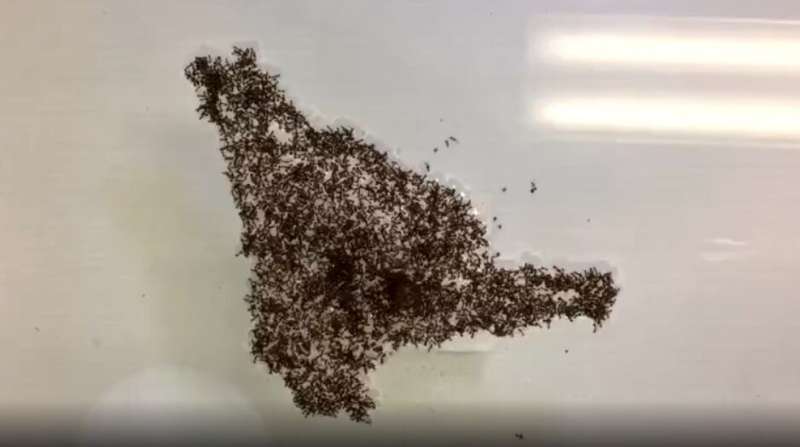July 1, 2021 report
Fire ants found to create 'appendages' on self-made rafts when put in water

A team of researchers at the University of Colorado has found that fire ants can create 'appendages' on the rafts they make out of their own bodies when they find themselves in water. In their paper published in the Journal of the Royal Society Interface, the group describes their study of the behavior of fire ants in water and what they learned.
Prior study of fire ants has shown them to be very highly organized when they swarm—they have been seen to use their own bodies as building material, for example, when the need arises. To do so, they grip each other with both claws and jaws, making their structure strong. Prior research has also shown that fire ant groups can behave as either a solid or liquid as they move through an environment. In this new effort, the researchers have found that fire ants can also alter self-made rafts to suit their purposes when dunked into water.
To learn more about how fire ants behave when dumped into water, the researchers collected a mass of them and then dropped them into a large tank of water in their lab. Close observation of the ants showed that, as expected, they clumped into a floating circle around a rod protruding from the center of the tank forming a raft from their own bodies. But then, over time, the ants changed the shape of the raft—arms began to form, like a starfish. As they continued to watch the ants, the researchers found the little creatures changed the shape of the raft continuously with some arms being retracted and new arms forming. They suggest the arms were formed as appendages—the ants were attempting to use them to find dry land.
In looking closer at the raft the ants built, the researchers found they were two-layered. On the bottom were the ants providing buoyancy for the raft. On top of them were ants marching around. It was the ants on top that began creating new arms—they did it by jumping off the raft into the water and grabbing the ants at the edges of the raft. They also found that the ants constantly circulated, with ants on the top of the raft moving to the bottom level and those on the bottom moving to the top. The researchers described it as sort of a conveyor belt, or treadmill.
More information: Robert J. Wagner et al, Treadmilling and dynamic protrusions in fire ant rafts, Journal of The Royal Society Interface (2021). DOI: 10.1098/rsif.2021.0213
Journal information: Journal of the Royal Society Interface
© 2021 Science X Network





















